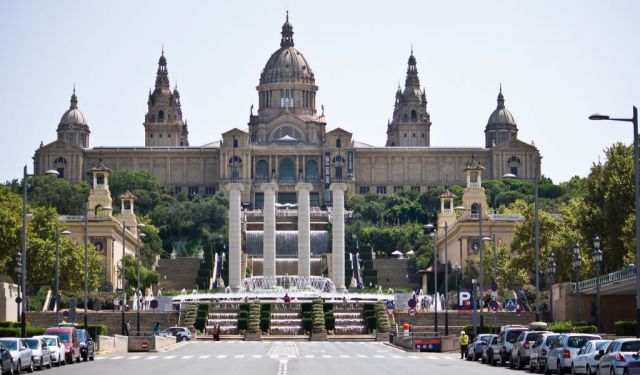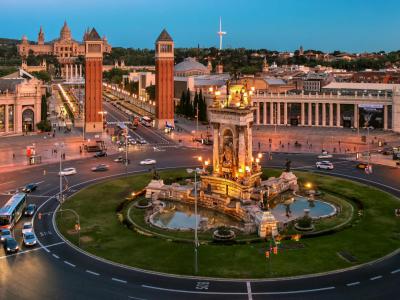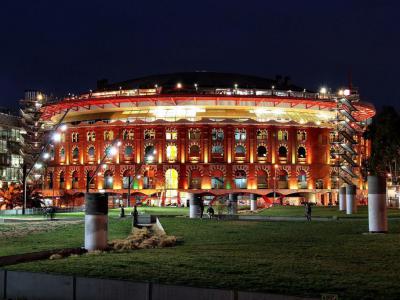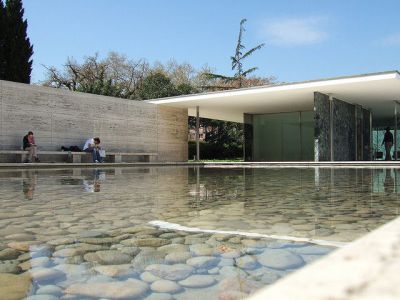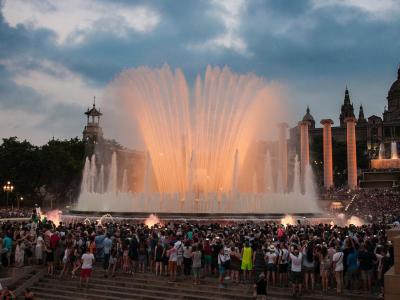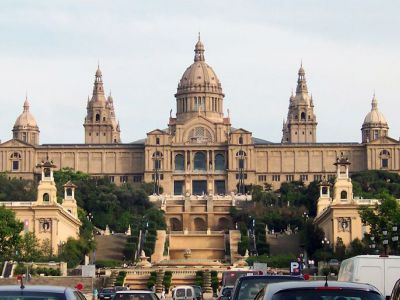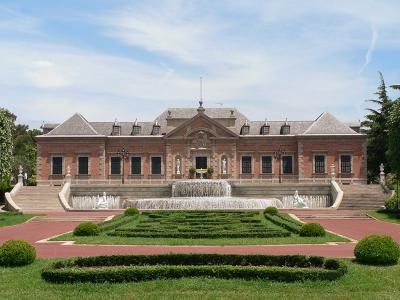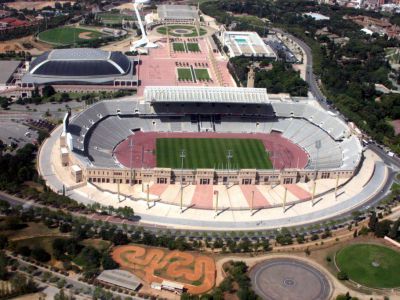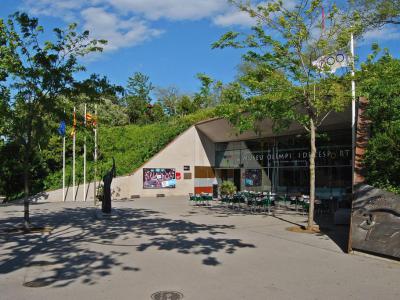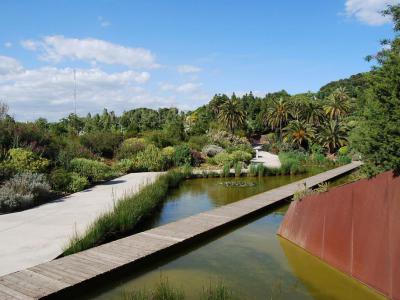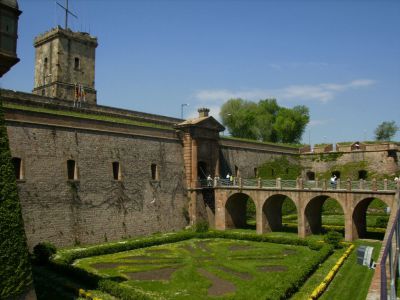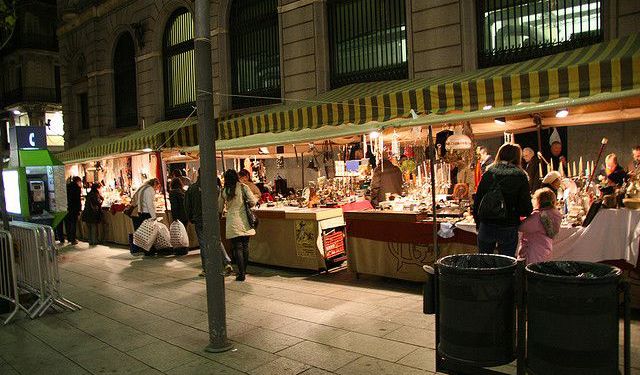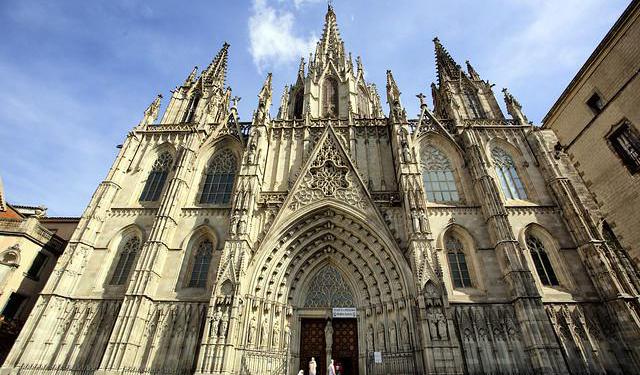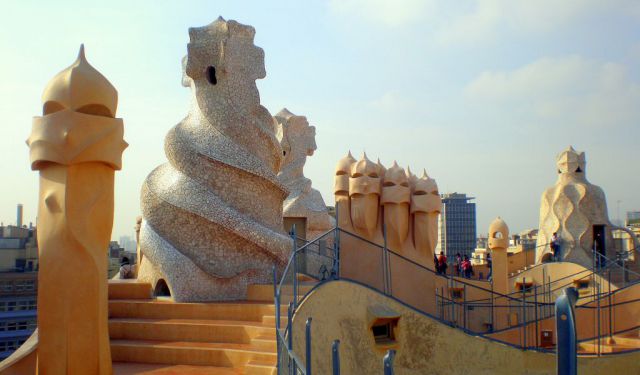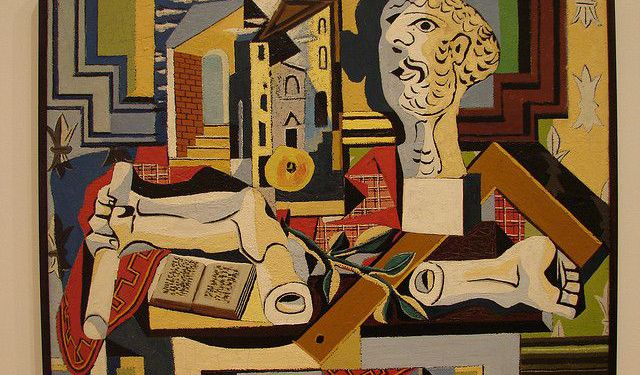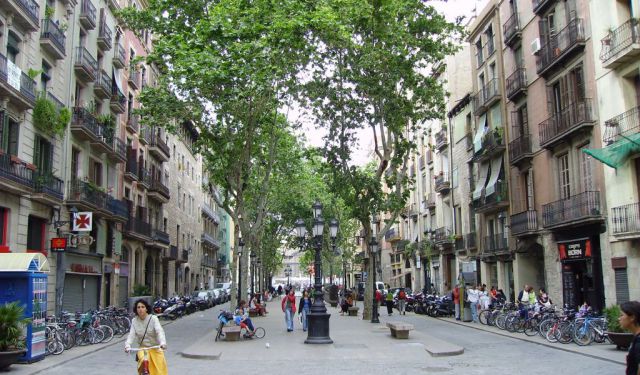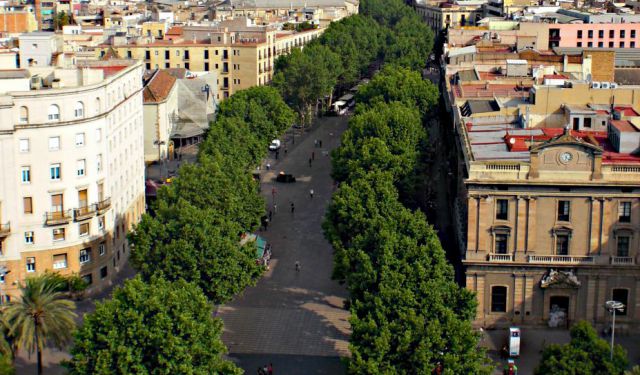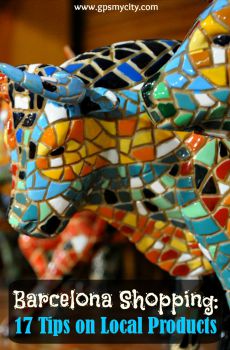Montjuic Walking Tour (Self Guided), Barcelona
Montjuic is a hill in Barcelona which offers a variety of great attractions of historic, cultural, and architectural value. Here, you can watch a spectacular water show at the Magic Fountain of Montjuic, visit the place where matadors faced the bulls in the past, and explore the ancient Montjuic Castle with its breathtaking views.
A convenient start point, Placa d'Espanya is the second largest square in Spain and will lead you to most other attractions in the area: from the old bullring of Las Arenas de Barcelona (now a shopping center after Catalonia’s abolition of bullfighting in 2012) to the elegantly sparse Barcelona Pavilion, to the Magic Fountain of Montjuic and neighbouring National Art Museum of Catalonia – one of the city’s most beautiful buildings, whose huge collection, as well as views from the top, are simply magical.
These alone make Montjuic an excellent place to visit, but you can carry on with a French-style royal palace and gardens (Albeniz Palace – only open at weekends!), the Olympics Stadium and associated museum, followed by the Botanical Garden, which is ideal for a short walk and to learn a bit about Mediterranean flora.
Standing atop the hill, the Montjuic Castle offers splendid views over the city, the port and the whole surrounding area, as well as lots of fascinating information on historic aspects via numerous electronic presentations of the castle itself and the personalities involved.
Discover the best spots of Montjuic with this self-guided walking tour today!
A convenient start point, Placa d'Espanya is the second largest square in Spain and will lead you to most other attractions in the area: from the old bullring of Las Arenas de Barcelona (now a shopping center after Catalonia’s abolition of bullfighting in 2012) to the elegantly sparse Barcelona Pavilion, to the Magic Fountain of Montjuic and neighbouring National Art Museum of Catalonia – one of the city’s most beautiful buildings, whose huge collection, as well as views from the top, are simply magical.
These alone make Montjuic an excellent place to visit, but you can carry on with a French-style royal palace and gardens (Albeniz Palace – only open at weekends!), the Olympics Stadium and associated museum, followed by the Botanical Garden, which is ideal for a short walk and to learn a bit about Mediterranean flora.
Standing atop the hill, the Montjuic Castle offers splendid views over the city, the port and the whole surrounding area, as well as lots of fascinating information on historic aspects via numerous electronic presentations of the castle itself and the personalities involved.
Discover the best spots of Montjuic with this self-guided walking tour today!
How it works: Download the app "GPSmyCity: Walks in 1K+ Cities" from Apple App Store or Google Play Store to your mobile phone or tablet. The app turns your mobile device into a personal tour guide and its built-in GPS navigation functions guide you from one tour stop to next. The app works offline, so no data plan is needed when traveling abroad.
Montjuic Walking Tour Map
Guide Name: Montjuic Walking Tour
Guide Location: Spain » Barcelona (See other walking tours in Barcelona)
Guide Type: Self-guided Walking Tour (Sightseeing)
# of Attractions: 10
Tour Duration: 3 Hour(s)
Travel Distance: 5.0 Km or 3.1 Miles
Author: RoseC
Sight(s) Featured in This Guide:
Guide Location: Spain » Barcelona (See other walking tours in Barcelona)
Guide Type: Self-guided Walking Tour (Sightseeing)
# of Attractions: 10
Tour Duration: 3 Hour(s)
Travel Distance: 5.0 Km or 3.1 Miles
Author: RoseC
Sight(s) Featured in This Guide:
- Placa d'Espanya (Place of Spain)
- Arenas de Barcelona
- Pavello Alemany (Barcelona Pavilion)
- Font magica de Montjuic (Magic Fountain of Montjuic)
- Museu Nacional d'Art de Catalunya / MNAC (National Art Museum of Catalonia)
- Palauet Albeniz (Albeniz Palace)
- Estadi Olimpic Lluis Companys (Olympic Stadium)
- Museu Olimpic i de l'Esport (Olympic and Sport Museum)
- Jardi botanic de Barcelona (Barcelona Botanical Garden)
- Castell de Montjuic (Montjuic Castle)
1) Placa d'Espanya (Place of Spain)
At some point during their stay in Barcelona, almost everyone finds themselves in the bustling traffic circle known as Plaça d'Espanya ("Place of Spain"), instantly recognizable by the presence of two life-sized replicas of Venice's Saint Mark's bell tower, which served as a gateway to the 1929 International Exhibition. Flanking the circle are two grand buildings dedicated to Work and Communications.
In the heart of this bustling roundabout stands a monumental fountain with a Baroque appearance, widely recognized as an iconic symbol of Barcelona. Interestingly, this fountain was commissioned as a last-minute addition in 1928 by the fair committee. What many may not realize is that it was designed by Josep Maria Jujol, a brilliant collaborator of Antoni Gaudí renowned for his spectacular tile work at Park Güell. Jujol's goal was to create a fountain that harmonized with the style of the 1929 International Exhibition, and he achieved this so perfectly that for many years it went largely unnoticed. Now, after receiving a meticulous restoration, the fountain gleams with a newfound radiance and is enchantingly illuminated at night.
Why You Should Visit:
An icon of Barcelona and also a transportation hub with shopping, dining, views, hotels, and lots of people. A great place to cool off and restore your energy while touring the city.
Tip:
Nice over day and night – try both! As the sun sets, the fountains may be turned off, but the illuminations come to life, transforming the surroundings and creating a whole new atmosphere to be enjoyed.
In the heart of this bustling roundabout stands a monumental fountain with a Baroque appearance, widely recognized as an iconic symbol of Barcelona. Interestingly, this fountain was commissioned as a last-minute addition in 1928 by the fair committee. What many may not realize is that it was designed by Josep Maria Jujol, a brilliant collaborator of Antoni Gaudí renowned for his spectacular tile work at Park Güell. Jujol's goal was to create a fountain that harmonized with the style of the 1929 International Exhibition, and he achieved this so perfectly that for many years it went largely unnoticed. Now, after receiving a meticulous restoration, the fountain gleams with a newfound radiance and is enchantingly illuminated at night.
Why You Should Visit:
An icon of Barcelona and also a transportation hub with shopping, dining, views, hotels, and lots of people. A great place to cool off and restore your energy while touring the city.
Tip:
Nice over day and night – try both! As the sun sets, the fountains may be turned off, but the illuminations come to life, transforming the surroundings and creating a whole new atmosphere to be enjoyed.
2) Arenas de Barcelona
On the northern side of Plaça d'Espanya you'll find the magnificent Moorish-style Arenas de Barcelona. Originally constructed in 1900 as a bullring, it underwent a remarkable transformation and reopened in 2011 as a stylish shopping and leisure center. One of its notable features is the horseshoe-shaped entrance adorned with exquisite tiles.
Interestingly, despite its initial purpose, bullfighting never gained significant popularity in Barcelona as anticipated, leading to the last bullfight taking place in 1977 and the arena remaining unused for an extended period. Presently, it not only houses a wide range of popular brands and specialty shops but also serves as a versatile venue for various events, including concerts. A particularly memorable concert was held in 1966, featuring the legendary performance of the Beatles.
On the upper level, visitors can enjoy a panoramic walk-around promenade encircling the dome, offering 360-degree views of the surroundings. Inside, the building boasts four floors filled with shopping options, entertainment facilities, including a cinema, gym, and an array of restaurants, with some located on the top-floor promenade.
Tip:
For direct access to the top, you can take the panoramic elevator for €1, which can be reimbursed by enjoying a meal or other offerings at the restaurants located on the upper deck.
Interestingly, despite its initial purpose, bullfighting never gained significant popularity in Barcelona as anticipated, leading to the last bullfight taking place in 1977 and the arena remaining unused for an extended period. Presently, it not only houses a wide range of popular brands and specialty shops but also serves as a versatile venue for various events, including concerts. A particularly memorable concert was held in 1966, featuring the legendary performance of the Beatles.
On the upper level, visitors can enjoy a panoramic walk-around promenade encircling the dome, offering 360-degree views of the surroundings. Inside, the building boasts four floors filled with shopping options, entertainment facilities, including a cinema, gym, and an array of restaurants, with some located on the top-floor promenade.
Tip:
For direct access to the top, you can take the panoramic elevator for €1, which can be reimbursed by enjoying a meal or other offerings at the restaurants located on the upper deck.
3) Pavello Alemany (Barcelona Pavilion)
Visitors to the 1929 International Exhibition would have been astonished by the modern and minimalist design of this pavilion. Designed by Ludwig Mies van der Rohe, the director of the innovative Bauhaus school, in collaboration with Lilly Reich, the pavilion featured sleek, glassy spaces that blurred the boundaries between interior and exterior, and employed materials such as marble and onyx. Its polished façades and generous use of tinted glass further enhanced its aesthetic appeal.
The pavilion featured two pools integrated into its surroundings, one of which was graced by a bronze replica of Georg Kolbe's statue, "Alba" (Dawn). Unlike other pavilions at the exhibition, this architectural marvel was conceived as a place of serenity and repose for visitors rather than a traditional gallery. It housed no exhibits except for the iconic Barcelona Chair, an exquisite creation made of ivory-colored pigskin, specifically designed for the Spanish royal family as they explored the exhibition's pavilions and displays.
Initially intended as a temporary structure, the pavilion was dismantled after the exhibition's conclusion. However, in honor of the designer's centenary, an exact replica was meticulously reconstructed in the 1980s, employing the same materials and attention to detail.
Tip:
For the ideal photograph of "Alba", one should position themselves at the far end of the pool, where the statue's reflection can be captured not only in the water but also in the glass façade on the left.
The pavilion featured two pools integrated into its surroundings, one of which was graced by a bronze replica of Georg Kolbe's statue, "Alba" (Dawn). Unlike other pavilions at the exhibition, this architectural marvel was conceived as a place of serenity and repose for visitors rather than a traditional gallery. It housed no exhibits except for the iconic Barcelona Chair, an exquisite creation made of ivory-colored pigskin, specifically designed for the Spanish royal family as they explored the exhibition's pavilions and displays.
Initially intended as a temporary structure, the pavilion was dismantled after the exhibition's conclusion. However, in honor of the designer's centenary, an exact replica was meticulously reconstructed in the 1980s, employing the same materials and attention to detail.
Tip:
For the ideal photograph of "Alba", one should position themselves at the far end of the pool, where the statue's reflection can be captured not only in the water but also in the glass façade on the left.
4) Font magica de Montjuic (Magic Fountain of Montjuic) (must see)
One of Barcelona's most spectacular attractions, this engineering marvel was constructed by Carles Buïgas (1898–1979) for the 1929 International Exhibition. The Art Deco fountain, a feat that required the efforts of 3000 individuals, enchants spectators with its synchronized water jets that dance to the rhythm of music, creating a symphony of light and sound. While the themes of the shows may vary, they often culminate in a captivating rendition of the popular duet "Barcelona" by Montserrat Caballé and Freddie Mercury, famously performed during the 1992 Olympics.
Standing behind the Magic Fountain are four columns originally erected by the Modernista architect Puig i Cadafalch at the turn of the 20th century. These columns, designed to symbolize the stripes on the Catalan coat-of-arms, were tragically destroyed in 1928 as part of a prohibition on Catalan symbols. However, they have been painstakingly rebuilt and now serve as a potent symbol of Catalan pride, reclaiming their significance.
The optimal time to visit is just before nightfall, prior to the commencement of the magical display. Each day, thousands of people gather around, finding a seat on the numerous steps that lead up to the MNAC museum, and relishing in the opportunity to witness the sunset from the vantage point of Montjuic mountain, beneath which the fountain resides. The show lasts approximately 10-15 minutes and is entirely free to enjoy, inviting visitors to immerse themselves in its ambiance.
Why You Should Visit:
Good (free) entertainment!
Tip:
Arrive at least 45 minutes in advance to secure a favorable spot, as the area tends to become quite congested. Feel free to bring along your favorite food and beverages to enjoy during the show.
Standing behind the Magic Fountain are four columns originally erected by the Modernista architect Puig i Cadafalch at the turn of the 20th century. These columns, designed to symbolize the stripes on the Catalan coat-of-arms, were tragically destroyed in 1928 as part of a prohibition on Catalan symbols. However, they have been painstakingly rebuilt and now serve as a potent symbol of Catalan pride, reclaiming their significance.
The optimal time to visit is just before nightfall, prior to the commencement of the magical display. Each day, thousands of people gather around, finding a seat on the numerous steps that lead up to the MNAC museum, and relishing in the opportunity to witness the sunset from the vantage point of Montjuic mountain, beneath which the fountain resides. The show lasts approximately 10-15 minutes and is entirely free to enjoy, inviting visitors to immerse themselves in its ambiance.
Why You Should Visit:
Good (free) entertainment!
Tip:
Arrive at least 45 minutes in advance to secure a favorable spot, as the area tends to become quite congested. Feel free to bring along your favorite food and beverages to enjoy during the show.
5) Museu Nacional d'Art de Catalunya / MNAC (National Art Museum of Catalonia) (must see)
An essential destination for visitors to Barcelona, offering a splendid setting that showcases a thousand years of Catalan art, the magnificent Palau Nacional, originally constructed for the 1929 International Exhibition, has been the home of the city's most significant art collection since 1934. For those unfamiliar with the museum, deciding where to begin can be challenging; however, if you have limited time, it is recommended to focus on the medieval collection, which is divided into two main sections: one dedicated to Romanesque art and the other to Gothic art. During these periods, Catalan artists were at the forefront of the art scene in Spain.
The museum takes great pride in its collection of Romanesque frescoes, which were carefully removed from churches in the Catalan Pyrenees and presented in a reconstructed version of their original settings. Additionally, the MNAC houses an unparalleled collection of 19th- and 20th-century Catalan art, with the exception of works from the 1950s onwards. The museum's collection excels in "modernista" and "noucentista" painting and sculpture, the two predominant artistic movements of that era. Moreover, visitors can explore intriguing exhibits on topics such as "modernista" interior design, avant-garde sculpture, and historical photography.
To fully appreciate the exhibits, it is advisable to plan for multiple visits as tickets are valid for 2 days. The museum's website offers a convenient "create your own itinerary" feature, helping you maximize your experience. Additionally, blockbuster exhibitions and special shows based on the MNAC's extensive archives are highly popular, although they may require separate ticket purchases.
Why You Should Visit:
An absolutely magnificent museum, newly updated and modernized for the contemporary tourist.
Reasonably priced; plenty of lifts/stair lifts/toilets, and comfortable leather sofas dotted here and there for when your feet ache.
Tip:
Not only does the on-site restaurant offer a breathtaking view of Montjuïc, but it also provides excellent value for the price.
Make sure not to miss the rooftop for an even more spectacular panorama.
The museum takes great pride in its collection of Romanesque frescoes, which were carefully removed from churches in the Catalan Pyrenees and presented in a reconstructed version of their original settings. Additionally, the MNAC houses an unparalleled collection of 19th- and 20th-century Catalan art, with the exception of works from the 1950s onwards. The museum's collection excels in "modernista" and "noucentista" painting and sculpture, the two predominant artistic movements of that era. Moreover, visitors can explore intriguing exhibits on topics such as "modernista" interior design, avant-garde sculpture, and historical photography.
To fully appreciate the exhibits, it is advisable to plan for multiple visits as tickets are valid for 2 days. The museum's website offers a convenient "create your own itinerary" feature, helping you maximize your experience. Additionally, blockbuster exhibitions and special shows based on the MNAC's extensive archives are highly popular, although they may require separate ticket purchases.
Why You Should Visit:
An absolutely magnificent museum, newly updated and modernized for the contemporary tourist.
Reasonably priced; plenty of lifts/stair lifts/toilets, and comfortable leather sofas dotted here and there for when your feet ache.
Tip:
Not only does the on-site restaurant offer a breathtaking view of Montjuïc, but it also provides excellent value for the price.
Make sure not to miss the rooftop for an even more spectacular panorama.
6) Palauet Albeniz (Albeniz Palace)
Situated just beneath the National Palace ("Palau Nacional"), you'll find the enchanting Maragall Gardens ("Jardins Maragall"), adorned with fountains and sculptures, which pay homage to the renowned Catalan poet. Adjacent to these gardens, you'll discover the elegant formal gardens of the Albéniz Palace, constructed in 1928 and named after the influential Catalan composer Isaac Albéniz (1860-1906).
This understated neoclassical royal palace, serving as the official residence for the King and Queen of Spain in Barcelona and hosting municipal banquets, is open to the public only on rare occasions, requiring prior written request and on special days. Fortunate visitors are greeted by a remarkable dome adorned with a painting by Salvador Dalí, representing his largest and one of the few existing works in Barcelona. A captivating fountain embellished with sculptures and two sculpted lions adorn the main entrance.
Come for the architecture the fountains, and the city views, accompanied by a diverse array of magnificent trees and plants, but be aware that visits are limited to weekends.
This understated neoclassical royal palace, serving as the official residence for the King and Queen of Spain in Barcelona and hosting municipal banquets, is open to the public only on rare occasions, requiring prior written request and on special days. Fortunate visitors are greeted by a remarkable dome adorned with a painting by Salvador Dalí, representing his largest and one of the few existing works in Barcelona. A captivating fountain embellished with sculptures and two sculpted lions adorn the main entrance.
Come for the architecture the fountains, and the city views, accompanied by a diverse array of magnificent trees and plants, but be aware that visits are limited to weekends.
7) Estadi Olimpic Lluis Companys (Olympic Stadium)
Open to visitors, this stadium, situated at the heart of the so-called "Olympic Ring" complex constructed for the 1992 Olympics, originally dates back to 1929 when it was built for the International Exhibition. Although its intended use for the Olímpiada Popular in 1936, designed as a protest against the Olympics held in Berlin under Hitler, was thwarted by the eruption of the Spanish Civil War, the stadium finally had its moment to shine during the 1992 Olympics. Extensively renovated for the games, it then accommodated 70,000 spectators while retaining its original facade.
In close proximity, you'll find the Olympic and Sport Museum, offering audiovisual displays from the 1992 Olympics, interactive simulations that allow visitors to experience the training and competition of Olympic athletes, as well as an information center tracing the history of the modern Olympics from Athens in 1896 to the present. Adjacent to the museum, downhill from the stadium, stands the futuristic "Palau Sant Jordi" Sports Palace, renowned as Barcelona's largest concert venue, designed by Japanese architect Arata Isozaki. Additionally, the Piscines Picornell, featuring a gym and both indoor and outdoor swimming pools, along with the diving pools used in the Olympics, are open during the summer months, providing magnificent views of the city.
In close proximity, you'll find the Olympic and Sport Museum, offering audiovisual displays from the 1992 Olympics, interactive simulations that allow visitors to experience the training and competition of Olympic athletes, as well as an information center tracing the history of the modern Olympics from Athens in 1896 to the present. Adjacent to the museum, downhill from the stadium, stands the futuristic "Palau Sant Jordi" Sports Palace, renowned as Barcelona's largest concert venue, designed by Japanese architect Arata Isozaki. Additionally, the Piscines Picornell, featuring a gym and both indoor and outdoor swimming pools, along with the diving pools used in the Olympics, are open during the summer months, providing magnificent views of the city.
8) Museu Olimpic i de l'Esport (Olympic and Sport Museum)
Just opposite the Olympic Stadium, the Olympic and Sports Museum offers a comprehensive exploration of the history and successful hosting of the 1992 Games in Barcelona. This immersive space provides an interactive experience, showcasing a wide array of sports equipment and fascinating memorabilia, including items from the personal collection of Juan Antonio Samaranch, the former President of the International Olympic Committee, to whom the museum is dedicated.
Utilizing multimedia technology to its fullest extent, visitors can engage with lifelike representations of renowned sports figures, creating an experience akin to stepping into a living building. The museum encompasses every facet of modern sports, featuring displays on various sports modalities, disciplines, regulations, and historical milestones.
Utilizing multimedia technology to its fullest extent, visitors can engage with lifelike representations of renowned sports figures, creating an experience akin to stepping into a living building. The museum encompasses every facet of modern sports, featuring displays on various sports modalities, disciplines, regulations, and historical milestones.
9) Jardi botanic de Barcelona (Barcelona Botanical Garden)
Among the many gardens found in Montjuïc, the city's notable 14-hectare (35-acre) Botanical Garden stands out. Established in 1999 and situated on terraced slopes, it offers magnificent vistas of the city. Positioned between the Olympic Stadium and Montjuïc Castle, this meticulously maintained modern garden features distinct landscaped sections that showcase the diverse flora of the Mediterranean, Canary Islands, California, Chile, South Africa, and Australia.
In a city renowned for its innovative architectural designs, the layout of this botanical garden is no exception. Departing from the traditional square-shaped botanical gardens commonly seen elsewhere, it takes on an unconventional form with a series of triangular areas designated for different botanical divisions. An additional fantastic aspect is that the garden offers various path options of different lengths, allowing visitors to customize their visit according to their preferred duration, whether they wish to stay for an extended period or just a short while. Just be mindful to avoid visiting during the peak heat of a summer day, as shade is quite limited.
In a city renowned for its innovative architectural designs, the layout of this botanical garden is no exception. Departing from the traditional square-shaped botanical gardens commonly seen elsewhere, it takes on an unconventional form with a series of triangular areas designated for different botanical divisions. An additional fantastic aspect is that the garden offers various path options of different lengths, allowing visitors to customize their visit according to their preferred duration, whether they wish to stay for an extended period or just a short while. Just be mindful to avoid visiting during the peak heat of a summer day, as shade is quite limited.
10) Castell de Montjuic (Montjuic Castle) (must see)
Perched at the very summit of Montjuïc, an 18th-century castle commands breathtaking views of the entire city and an expansive stretch of coastline. The initial fortress was constructed in 1640 and witnessed numerous battles during the War of the Spanish Succession in the early 1700s. Following the triumph of Felipe V, the Montjuïc fortress was reconstructed by the Bourbon rulers to maintain control over the local population. Infamous for its role as a prison and torture center, it continued to serve this purpose until after the Civil War, where notable Catalan leaders, including Lluís Companys, were imprisoned and executed.
While the castle once housed a military museum, the formal restoration of the castle to the Catalan authorities by the Spanish government in 2008 led to the transformation of the museum into a center dedicated to peace. Exhibits now chronicle the evolution of Montjuïc and the castle's tumultuous history. The castle's cable car ride and its dramatic location alone make it worth a visit. The views from the ramparts are truly magnificent, and below the castle walls, the panoramic Camí del Mar pathway stretches for one kilometer, leading to the Mirador del Migdia viewpoint. At this viewpoint, visitors can enjoy the pleasant outdoor bar named La Caseta, offering a great escape from the city and the added bonus of cool harbor views during the summer months.
Why You Should Visit:
Ideal for a lazy afternoon and quite fun to get to, taking the funicular railway first, then either the cable car (quite expensive but great views) or the bus (not so scenic but free on a T10 ticket).
Tip:
If you prefer to climb by foot, be prepared for a considerable amount of stair climbing, so please wear sturdy and comfortable shoes.
While the castle once housed a military museum, the formal restoration of the castle to the Catalan authorities by the Spanish government in 2008 led to the transformation of the museum into a center dedicated to peace. Exhibits now chronicle the evolution of Montjuïc and the castle's tumultuous history. The castle's cable car ride and its dramatic location alone make it worth a visit. The views from the ramparts are truly magnificent, and below the castle walls, the panoramic Camí del Mar pathway stretches for one kilometer, leading to the Mirador del Migdia viewpoint. At this viewpoint, visitors can enjoy the pleasant outdoor bar named La Caseta, offering a great escape from the city and the added bonus of cool harbor views during the summer months.
Why You Should Visit:
Ideal for a lazy afternoon and quite fun to get to, taking the funicular railway first, then either the cable car (quite expensive but great views) or the bus (not so scenic but free on a T10 ticket).
Tip:
If you prefer to climb by foot, be prepared for a considerable amount of stair climbing, so please wear sturdy and comfortable shoes.
Walking Tours in Barcelona, Spain
Create Your Own Walk in Barcelona
Creating your own self-guided walk in Barcelona is easy and fun. Choose the city attractions that you want to see and a walk route map will be created just for you. You can even set your hotel as the start point of the walk.
Barcelona Shopping Walk
A long-time prime cultural destination, Barcelona is also en route to becoming one of Europe's top shopping spots. Each new day, fashionable designer stores, from well-known international brands to local start-ups, are filling the city streets. If you're a fan of shopping, you're in for a treat when visiting this beautiful city. Here are some of the most popular shopping locations... view more
Tour Duration: 2 Hour(s)
Travel Distance: 3.4 Km or 2.1 Miles
Tour Duration: 2 Hour(s)
Travel Distance: 3.4 Km or 2.1 Miles
Barcelona Introduction Walking Tour
According to legend, Barcelona was founded by the mythological Greek hero Hercules on one of his expeditions, when a storm hit his boats. The first eight boats managed to escape without damage, but the ninth was lost at sea. Hercules found his lost friends some days later on the coast, all safe and sound. The boat's crew, taken by the beauty of the coastal landscape, decided to stay. On that... view more
Tour Duration: 3 Hour(s)
Travel Distance: 5.7 Km or 3.5 Miles
Tour Duration: 3 Hour(s)
Travel Distance: 5.7 Km or 3.5 Miles
Antoni Gaudí's Masterpieces Walking Tour
Antoni Gaudi, a seminal figure in the Catalan Modernism movement, is one of the top architects of the 20th century. The unique technique and use of natural forms in his works stand out from the pack and have left an indelible mark on the face of Barcelona.
Our journey through Gaudi's Barcelona begins at the Güell Palace, by far the most budget-friendly of his projects. Located near La... view more
Tour Duration: 2 Hour(s)
Travel Distance: 4.6 Km or 2.9 Miles
Our journey through Gaudi's Barcelona begins at the Güell Palace, by far the most budget-friendly of his projects. Located near La... view more
Tour Duration: 2 Hour(s)
Travel Distance: 4.6 Km or 2.9 Miles
Picasso's Barcelona Walking Tour
Pablo Picasso – the great Spanish painter and sculptor – developed his style in Barcelona where he spent the formative years of his life, from the ages of 14 to 23. It is said that when the master spoke nostalgically of home, he actually meant the Catalonian capital, despite having been born in Malaga.
This self-guided walk will take you to the Picasso Museum, the bar-restaurant and the art... view more
Tour Duration: 2 Hour(s)
Travel Distance: 4.2 Km or 2.6 Miles
This self-guided walk will take you to the Picasso Museum, the bar-restaurant and the art... view more
Tour Duration: 2 Hour(s)
Travel Distance: 4.2 Km or 2.6 Miles
La Ribera Walking Tour
La Ribera is a culturally rich, historic area of Barcelona’s Old Town; somewhat less touristy than the Gothic Quarter (which one should really visit as well) and quite unspoiled, authentic and pretty. Centuries ago, it was a very well-to-do neighborhood inhabited by aristocrats, merchants, wealthy sailors, and Jewish money-lenders. Today, it is regarded as the Soho of Barcelona – a popular... view more
Tour Duration: 2 Hour(s)
Travel Distance: 2.8 Km or 1.7 Miles
Tour Duration: 2 Hour(s)
Travel Distance: 2.8 Km or 1.7 Miles
La Rambla Walking Tour
One of the main streets in central Barcelona, La Rambla is popular with tourists and locals alike. Connecting the city’s old port with Plaça de Catalunya, it is filled with cultural and historic landmarks, as well as many terraces, restaurants, shops and street artists. Spanish poet, Federico García Lorca once said it was “the only street in the world which I wish never ended.”
Start... view more
Tour Duration: 1 Hour(s)
Travel Distance: 2.3 Km or 1.4 Miles
Start... view more
Tour Duration: 1 Hour(s)
Travel Distance: 2.3 Km or 1.4 Miles
Useful Travel Guides for Planning Your Trip
Barcelona Souvenir Shopping: 17 Uniquely Spanish Things to Buy
Spain, in general, and Barcelona, in particular, are a treasure trove of all things exciting. Set your foot in Barcelona and you'll be spoiled for the choice of things worth trying and taking home. Before your head starts spinning, check this guide out to put yourself in the right...
Top 10 Spanish Foods and Drinks to Try in Barcelona
In the countries like Spain, food is a national heritage and cultural attraction in its own right. The latter is even more true of Catalonia in general and Barcelona in particular. Presented here are the 10 staples of Catalan food tradition, missing which would be a gastronomical...
The Most Popular Cities
/ view all
